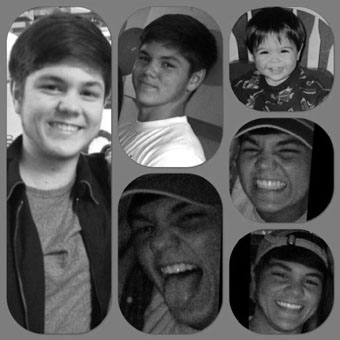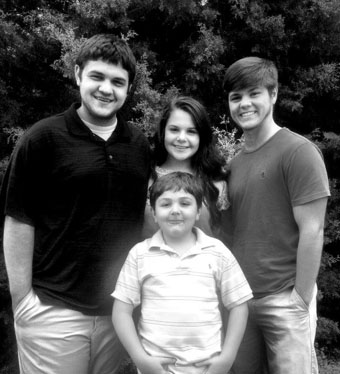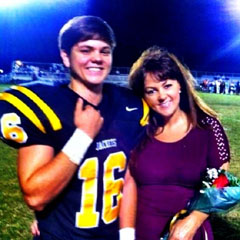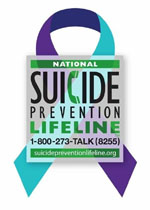
Dying to be Loved:
The Final Footprints of Blake Coatney
| published September 12, 2015 |
By Jennifer Walker-James
Thursday Review features writer
Words were spoken. A heart was crushed. A video was made. A trigger was pulled. A young person’s life was ended. July 21, 2014 was as mundane as any other summer day in the sleepy southern town of Ashford, Alabama. Grey clouds veiled the afternoon sky with empty threats of rain. Their presence—a welcome sigh of relief keeping temperatures from soaring to into the triple digits. Conversations at the local businesses were periodically interrupted by the screaming whistle of the daily CSX train roaring through downtown with its thunderous cadence. It had been less than six weeks since the community lost one of its own—a seventeen year old to leukemia. Still riveted with grief from the tragic loss of Cody Hayes, residents trudged forward with their daily lives on that bleak Monday afternoon. Not one of them ever suspected that by day’s end, this town of 2,159 would yet again suffer the loss of another young life—least of all to suicide.
At only 18 years of age, Blake Michael Coatney had just graduated high school and was looking at a promising future with the Air National Guard. Known by many for his winsome smile and his enduring generosity, Blake was a beacon of happiness and light to those around him. But only on the outside, that is. Behind his contagious smile was a painful secret. Internally, he was suffering—a darkened truth that even those closest to him could not fully realize until it was too late. The question of what triggered this vivacious teenager to take his own life will forever remain a mystery. There will always be speculations, opinions, and rumors. But Blake’s life can’t be summed up by the circumstances by which it was ended. Like so many others that are lost at the hands of suicide, Blake’s life was worth more than that.
The week of September 7th through 11th marked National Suicide Awareness Week, a part of Suicide Prevention Month, according to the U.S Surgeon General. It is designated to promote understanding and bring attention to this tragic epidemic that is sweeping the nation. Blake’s mother, Catherine Coatney, has come forward to share her son’s tragic story, to shed light on what was once a taboo subject and, hopefully, save lives.
We’ll begin by first, getting acquainted with the boy whose untimely death spurred irreversible change in the social climate of Ashford, Alabama.


We went walking that afternoon and I left my phone on the charger. At 4:24 p.m., he sent me a text that said:
“There’s a video on my phone I want you to watch and show everyone. I love you and everyone else. My password is 8816. God bless, Momma.”
I didn’t see the message until we got back around 5:30 p.m. Immediately, I called his best friends and his dad and told them to go looking for him. And then, my daughter, Brooke, and I hit our knees and started praying, but I knew deep down that my baby was gone…
An hour and a half later, Catherine’s phone rang and her worst fears were realized when she answered only to hear Blake’s best friend screaming on the other end.
Blake’s friends found him, dead and unrecognizable, having suffered a self-inflicted gunshot wound to the head. His lifeless body lay slumped over the grave of his best friend, Cody, who had died of cancer less than six weeks prior.

A shockwave of sadness echoed through the already grief-stricken community that dreary Monday. In its wake, another pang of tragedy and guilt from which those who knew Blake will never recover. And of course, there amidst the pandemonium a question arises: “Why?” Why would such a handsome boy with the world at his feet, want to give up on the beautiful life that lay ahead of him?
At 4:21 p.m., Blake left a voicemail on his ex-girlfriend’s phone. His voice, uneven with grief, offered her these last words: “Hey…I just wanted to tell you that I love you and I hope I’ll see around someday….” His call would never be returned.

At 4:24 p.m., he sent his mom that final text. Sources close to the investigation speculate that Coatney’s life ended only minutes later, between 4:30 and 5:00 p.m. His final moments were documented in an 8 minute and 31 second video on his cell phone—the video mentioned in his final text to his mom. In what would be his last farewell to family and friends, Blake sobbingly offers a tragic glimpse at the pain he was suffering. He weeps inconsolably as he describes the torture of losing his best friend to cancer, the disloyalty of people in today’s society, lost love, and other painful circumstances contributing to his fateful decision.
Like so many others, Blake’s death was something that even his family and closest friends never saw coming—a tragic commonality existing among suicides across the nation. By bringing awareness to suicide and its prevention, advocates and survivors like Blake’s mom, Catherine, are sharing their story in hopes to reach others before it is too late.
The American Foundation for Suicide Prevention was developed with people like Blake and his family in mind. Its mission: to educate the public on this once-taboo subject. By understanding more about its causes, signs, and ways to offer help, suicide can be prevented and more lives can be saved. Their website, www.afsp.org, lists the following three categories to search for typical red flags indicating that someone might be at risk for suicide:
Talk: If a person talks about killing themselves, having no reason to live, being a burden to others, feeling trapped, or suffering unbearable pain.
Behavioral Changes: If a person’s behavior is new or increased in relation to a painful event, loss, or change. These behaviors might include substance abuse, reckless behavior, isolation, sleeping too much or too little, visiting or calling people to say goodbye, giving away prized possessions, aggression, and fascination with death, including researching suicide methods online.
Mood: People who are contemplating suicide often exhibit moods of depression, loss of interest, rage, irritability, humiliation, and anxiety.

Catherine, a native of Michigan, and her son, Trent, have since moved back to her home state to be closer to family. But no matter where she resides, she carries Blake’s message to promote suicide awareness. Her advocacy efforts not only keep his memory alive, but they continue to give his story a more hopeful ending by prompting others to get the help they need.
On July 21, 2014, Blake Coatney’s winsome smile and charismatic charm were wiped clean from existence, but will never be erased from the memory of those who knew and loved him. For more on his story and how you can get involved in the movement, go to www.blakecoatney.com.
Suicide is the 10th leading cause of death in the U.S. for all ages. Every day, approximately 105 Americans die by suicide, according to the CDC. There is one suicide for every 25 suicide attempts. Only half of all Americans experiencing an episode of major depression receive treatment. If you or someone you know is struggling with depression and thoughts of suicide, there is help available at www.suicidepreventionlifeline.org. You can also call their hotline at 1-800-273-8255 where a counselor is ready to assist any time of day, seven days a week. One life lost to suicide is one too many.

Related Thursday Review articles:
Breaking Their Silence: Sisters & Family Talk About Two Unsolved Murders; Jennifer Walker-James; Thursday Review; August 21, 2015.
Bittersweet 16: The Harrowing Story of an Unsolved Murder; Jennifer Walker-James; Thursday Review; August 1, 2015.
